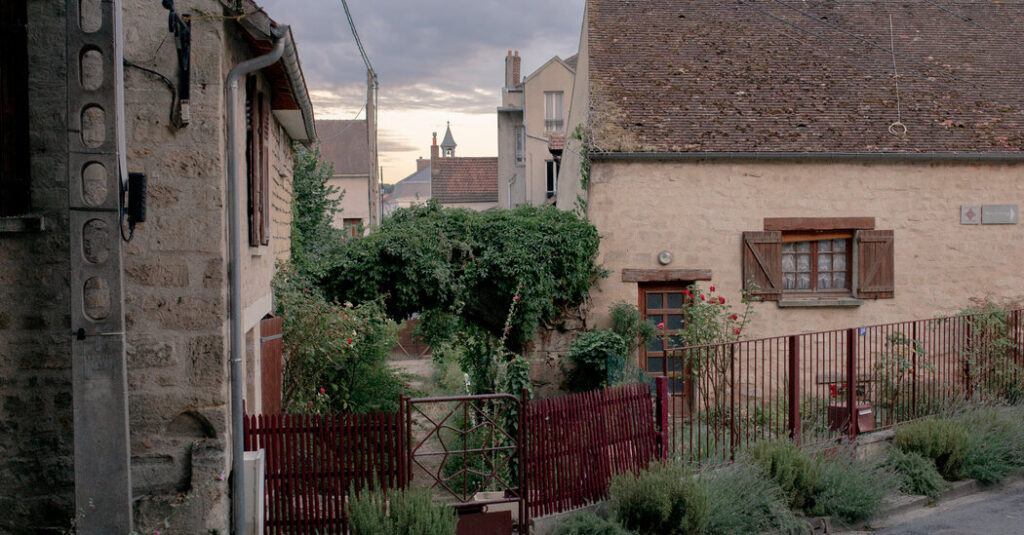Auvers-sur-Oise, a village near Paris famed as an artist’s paradise, is also where Vincent Van Gogh spent his final days and it has long drawn tourists to walk in the tortured painter’s last footsteps. But ever since art experts identified his final work before he took his life, there has been strife in the town.
Van Gogh’s final painting was disputed for decades, because he didn’t date his works. But in 2020 experts concluded that gnarled tree roots protruding from a hillside in Auvers, as depicted in his “Tree Roots,” was made on the day he died. This finding may have settled one dispute, but it immediately stirred another, this one between the municipality and the owners of the property where the roots grow.
The main root depicted in the painting — from a black locust tree and dubbed the “elephant” by enthusiasts — abuts a public road. After the discovery of its historical value, the municipality claimed a section of privately owned land near the road as public domain, saying it was necessary for maintenance. Jean-François and Hélène Serlinger, the property owners, fought the village, and an appeals court recently concluded there was no basis for the municipality’s claim.
But the mayor of Auvers, Isabelle Mézières, has pledged to keep fighting, and she can still appeal to a higher court. After the decision, she insisted that the site should belong to the public, not private owners. “The Roots belong to the Auversois!” she wrote on social media, referring to the citizens of the region.
The continued fight over Van Gogh’s tree roots has cast a pall over what is usually a celebratory season in Auvers, population 7,000, where art tourism is a big business that heats up in the spring.
That the village has been depicted by other notable painters, including Pierre Auguste Renoir, Paul Cezanne and Camille Pissaro. has only added to its attraction. Its popularity is such that the French transit authorities run a seasonal line from Paris, dubbed the “Impressionists’ Train,” and people come from afar to see what the local tourist board calls “the open-air museum that Auvers has become over time.”
The property owners say the conflict is endangering the historic site, as the mayor has blocked them and experts from properly protecting the roots since their significance was established. In a phone interview, Mr. Serlinger accused the municipality of using the administrative case as a pretext for “an attempted takeover of a culturally significant site” and of simultaneously endangering the roots by “obstructing the installation of a permanent protective structure.”
The municipality and the mayor declined requests for comment. But it is perhaps fitting that these tree roots should be the subject of such a knotty dispute.
Van Gogh’s famous painting depicting the tangled tree shows “the struggle of life, and a struggle with death,” Wouter van der Veen, the researcher in France who identified the roots, said in 2020.
Still, the painting is bright and lively, made at the end of a productive period in Van Gogh’s troubled existence — after he famously cut off his ear and spent time in an asylum — and the village celebrates the Dutch painter whose work was rejected in life and embraced after his death. Van Gogh is a major attraction, including for the Serlingers.
The couple moved to Auvers in 1996 because Mrs. Serlinger, an artist, wanted to live where Van Gogh had worked. In 2013, they bought a small additional parcel of land near their house, connected to their yard, extending their territory. Only years later did it turn out that the roots on that new property were an important part of art history.
Now, the roots have their own website and nonprofit organization, run by the Serlingers, who say they want to protect the location for the public to enjoy. They’ve partnered with the Van Gogh Europe Foundation, which brings together key locations and museums linked to the painter under the direction of the Van Gogh Museum in Amsterdam. Last year, the Serlingers began opening their yard to visitors for tours.
Mr. Serlinger insists the couple did not intend to make their yard into a destination and has not profited from the tours. He noted that the main root is mostly visible to the public from the road, though the municipality has placed a 10-foot sign there highlighting the find that partially obstructs the view and “disfigures the front of the site.”
It was the enthusiasm of art experts and academics visiting them over the years, that convinced the couple to open up their land to the public, he said. They now charge about $9 for a 30-minute “walk through the landscape of Van Gogh’s final painting,” he added, with funds going to preservation costs.
Saturday was the start of the new tourist season. But the dispute has unsettled the property owners and raised concerns about the preservation of the roots.
“It created a deep sense of insecurity around a site that calls for calm and serenity,” Mr. Serlinger said. “We have a feeling of insecurity with a mayor who is still in a war.”



